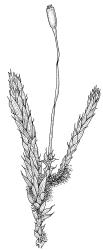Plants forming cushions usually on bark or rock. Stems creeping and much branched, forming a densely intertwined mat and giving rise to numerous erect branches. Microphyllous secondary branches frequently present. Leaves lanceolate, oblong-lanceolate, or broadly oblong, often plicate, unbordered, serrulate above, not decurrent, usually abruptly tapered to a fine acumen or pilifer that is uniseriate apically; mid laminal cells vermicular, smooth, firm-walled, variably porose; cells at insertion shorter and wider; alar cells not or poorly differentiated. Costa single, often branched, weak and usually less than ½ the leaf length. Axillary hairs reportedly present.
Dioicous, sometimes with dwarfed ♂ plants. Capsules erect, symmetric, smooth and weakly constricted below the mouth when dry; exothecial cells irregular in outline, l:w mostly less than 2:1, firm-walled; stomata restricted to capsule base; annulus persistent, composed of a single row of cells. Peristome single or double; exostome teeth absent or rudimentary; endostome hyaline, with a low basal membrane and narrowly perforate segments, linear or irregular in outline, lacking nodules and appendiculae; cilia usually absent but rarely rudimentary. Operculum obliquely rostrate from a high conic base. Calyptra cucullate, smooth. Spores spherical, smooth or nearly so.
A genus of c. seven species distributed almost exclusively in tropical and temperate South America and Australasia; a single species extends northward into Mexico and the Caribbean islands. The genus was monographed by Allen (1999), but not all of his taxonomic decisions are accepted here.
| 1 | Well-developed leaves 2–2.5 mm long, markedly plicate, not rugose or rugose only at extreme apices when dry, moderately concave; mid laminal cells mostly 4–5 μm wide; peristome single, lacking an exostome | L. australis |
| 1' | Well-developed leaves to 4.0 mm long, not plicate, rugose throughout when dry, strongly concave; mid laminal cells mostly 6–9 μm wide; peristome double, usually with a weakly developed exostome in N.Z. material | L. lagurus |
| Category | Number |
|---|---|
| Indigenous (Non-endemic) | 2 |
| Total | 2 |




